
Veterinary Science
Longitudinal evaluation of fecal microbiota transplantation for ameliorating calf diarrhea and improving growth performance
H. S. Kim, T. W. Whon, et al.
Calf diarrhea poses a major risk in livestock management, often requiring antibiotic intervention. This groundbreaking research by Hyun Sik Kim and colleagues investigates fecal microbiota transplantation (FMT) as a viable alternative, demonstrating its potential to alleviate diarrhea and improve calf growth performance over two years. Discover the promising outcomes that could reshape treatment approaches in veterinary science!
Playback language: English
Related Publications
Explore these studies to deepen your understanding of the subject.







